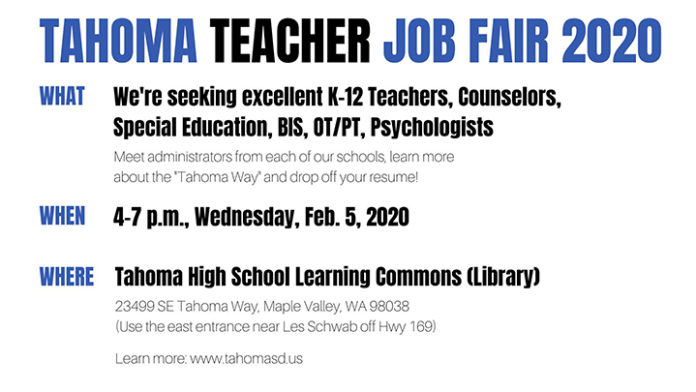The largest portion of the Educational Programs and Operations (EP&O) Levy pays for the supplemental teacher contract. The district’s supplemental contract with the Tahoma Education Association helps support zero hour classes, elementary art and STEM classes, and positions such as academic advisers of clubs and activities. It also helps pay for other certificated positions such as Behavioral Intervention Specialists, psychologists, counselors and more.
Contractually, about 12.7 percent of teacher salary is provided by local levy dollars. This is not part of basic education; it is Professional Learning and Enrichment as allowed by the state Legislature.
The teachers’ Tahoma Education Association contract states, “We recognize that basic education funding does not compensate staff for the time necessary to complete all the required educational duties determined by the Tahoma School District.” Part-time employees receive a pro-rated share of the supplemental pay. The contract also states that teachers will receive the additional 12.7 percent when the EP&O levy is being collected.
Tahoma’s teachers and certificated staff, and the programs and support they provide, are a large part of the daily student experience, as are bus drivers, front office staff, custodians and nurses.
“What are some of those things that make Tahoma such a special place?” Shadow Lake Principal Mike Hanson asked at one of last week’s levy information sessions. “What are some of those things that are ‘beyond basic’ that we’ve come to expect for our kids?”
Hanson talked about the district’s annual hiring cycle, which typically begins in about February. People who work for other surrounding districts seek out jobs in Tahoma because “This is a great place to work.”
At each building in Tahoma, he pointed out, it’s the individuals who drive school buses, greet students in the office — and teach — that truly make up the school.
“As community members, how do we define ‘basic education?’” Hanson asked. “Are these activities and clubs a part of it? Are athletics a part of it? Are field trips a part of it?”
Those programs, along with others such as increased mental health support, zero hour classes, elementary art and STEM, the Extended Enrichment Program, academic coaches, and drama are primarily funded by local levy dollars. As an example, athletics and extracurricular activities cost the district $1.46 million for 2019-2020. Of that, $1.35 million comes from the Educational Programs and Operations Levy, which is up for replacement on the February ballot.
“Our kids do phenomenally academically. They really do,” Hanson said. “But part of the reason is because they’re connected to school. They wake up in the morning wanting to go participate in drama, or they have a connection to that bus driver, or they have that connection to that secretary in that school. … Our academic success is tied directly to the programs that we offer at our schools.”
It’s the high-quality teaching and staff position candidates that Tahoma attracts that make the district what it is, he emphasized. “This is a special place.”
Most people can think of one or more school staff members who were instrumental in helping them make it through their school years — a music teacher who always asked about their day or a coach who inspired them.
Parent Laura Meyers shared one such story at one of last week’s public meetings. The middle school drama program was the element that made the difference for her daughter, who they had pulled out of school and were homeschooling for a majority of the day last year. When her daughter auditioned for the middle school musical and experienced the camaraderie and teamwork that happened as the production came together under the direction of Cheri Ayres-Graves, it was the unknown thing that they had been looking for.
“She found a group of individuals that became her family. Her measure of success, and what was successful to me — and we take it one day at a time — is she is back in school full time because of her experience with junior drama. … How we define success? It isn’t basic education for me.”
Although Ayres-Graves is not a Tahoma teacher, she is paid as the adviser of the middle school drama program through the TEA supplemental contract, which is not covered by the state.
Teachers say that their salary and supplemental contract are certainly not the only reasons they want to work in the district — but that it is a factor.
Asked why he works for Tahoma, Rock Creek teacher David Aaby, who is also president of the Tahoma Education Association, said “I think a huge part of it is the community of Tahoma. The families and the community are so supportive of the teachers. As a teacher, I feel that.”
“For teachers, when they’re looking for a place to work, they want to feel valued,” Aaby said. “I think our community does a great job of that, but part of that is also our salary. … In Tahoma, it’s the best of both worlds. You have a very supportive community, but we’re also compensating our teachers competitively when you look at surrounding districts.”
The state-funding changes from the McCleary lawsuit have helped, but levy dollars are still vital to the big picture, and help pay for all the things that the state does not consider basic education, Aaby said.
Kendall Boland is a 2015 Tahoma High School graduate and a new teacher at Tahoma Elementary, where she teaches first grade. Boland said there are many reasons she wanted to return to the district she attended growing up, but that the top factor for her is her fellow teachers.
“When I was at Tahoma, I was exposed to fabulous teachers — my own teachers,” Boland said. “My first grade teacher was Patty Kiffer. She made such a big impact on me that I have always wanted to be a teacher, ever since first grade.”
Before returning to teach in Tahoma, she had the opportunity to work in a Title I school in Oregon, which helped solidify her desire to seek a job with TSD.
“The staff support, the community support and the principal support are amazing,” Boland said. “I think a big reason I love Tahoma is there are so many opportunities for all our kids, and here in Tahoma we really do all care for all our kids. I have a few kids in RAP, and it’s not just me caring for those kids. It’s the RAP teachers, the speech teachers and all the other staff who support the kids. I think it makes our district really unique.”
With four months at Tahoma Elementary under her belt, she says she feels she made the right choice. Boland teaches in a (renovated) classroom that she sat in as a student in sixth grade, and Kiffer is now her instructional coach.
“I’m glad I’m back. This is where I’m meant to be, and where I can make a huge impact.”







